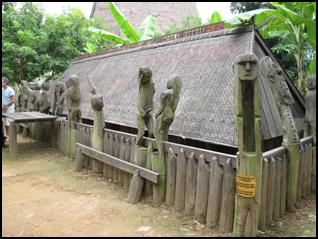

A Delightful Tour Of North Vietnam
(18th to 25th Sept, 2009)
A Delightful Tour Of North Vietnam Without much planning, my wife and I embarked on a 7-day tour of North Vietnam. The areas covered were Hanoi City, Tam Coc boat cruise, Sapa and Halong Bay. It was a delightful journey of discovery. ...read more |
A. Introduction
Indochina occupies the easternmost region of the Indochinese Peninsular, located directly east of Thailand and south of China. It comprises of three independent countries, Laos, Cambodia and Vietnam.
In year 2005, my trekking friends and I went to Laos and Cambodia on a journey of discovery. This time around I went with my wife, Lucy to North Vietnam to complete my journey of discovery in Indochina.
As Vietnam is a huge country, we only concentrated our visits to North Vietnam.
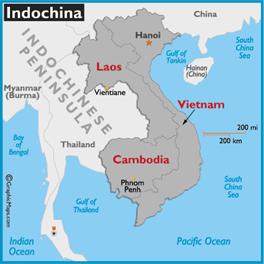 |
 |
B. Itinerary
I contacted Tokin Travel in Hanoi and requested them to put up an itinerary to tour N Vietnam for a week, from 18th to 25th Sept. The tour had to include Hanoi, Sa Pa and Halong Bay. Within a day, I received from one Mdm Ly a tentative itinerary. After a couple of changes, the itinerary was finally accepted by me within 24 hours!
Brief Itinerary
Day1. 18 Sept. - Arrive Hanoi by VN 756 @ 1930. Transfer to Gia Bao Grand Hotel.
Day2. 19 Sept. - Hanoi Tour & overnight train to Lao Cai (2110 – 0530).
Day3. 20 Sept. – Tour Lao Cai, Bac Ha and Sa Pa. Hotel: Sapa Room.
Day4. 21 Sept. – Tour Sapa Valley by foot to Lao Chai, Ta Van Giay and Giang Ta Chai villages. Overnight train to Hanoi (1930 – 0435)
Day5. 22 Sept. – Hanoi to Halong Bay. Cruise in Lagoon Junk.
Day6. 23 Sept. – Continue cruising in Halong Bay and return to Hanoi.
Day7. 24 Sept. – Hanoi to Hoa Lu and boat trip to Cam Coc. Back to Hanoi.
Day8. 25 Sept. – Hanoi to KLIA (VN 757 leaving 0630).
The details of the program for each day given in the itinerary are quite elaborate and it looks like we would have a busy tour of N Vietnam with very little time for our own.
But during the tour we discovered that on some days the programs of visits were too short which ended early at noon. And the worst was this happened when we had to travel by train at night to our next destination i.e. on Day2 and Day4. To overcome this problem the tour agent should either include more visits or extend the stay in the hotels to the evenings during these days.
The day after our arrival, the tour guide came to pick us up for the Hanoi City tour as programmed. But he told us that the tour would finish by 3.00pm and we had to hang around until 8.00pm to be transferred to the train station for our overnight journey to Lao Cai. He suggested that instead of the City tour we could do the Hoa Lu and Cam Coc boat trip instead which would last until 5.30pm. This would reduce our waiting time for the train journey to Lao Cai. The Hanoi City tour would be done after our return for Halong Bay Cruise. We agreed to the change without any hesitation.
C. Tour of North Vietnam
C1. Hanoi City Tour
a. General
In Chinese, Ha Noi means (??) “He Nei” “He” means “river” and “Nei” means “within”. Therefore Ha Noi means “within the river”. It is the capital of the Socialist Republic of Vietnam and is located on the bank of the Red River with Hoan Kien Lake at its city centre. It has a population of over 6 million people.
Hanoi has a fascinating blend of east and west with Chinese influence in culture and language from centuries of its dominance and French architectural design in buildings from its colonial past.
The city was extensively bombed by the Americans during the Vietnam War (1965 to 1973). But the facades of most new buildings in Hanoi still retain the French design.
 |
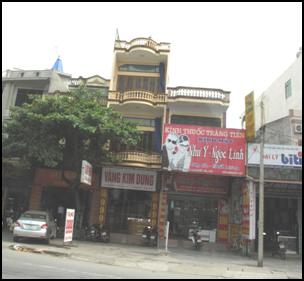 |
The old & the New New narrow building
Hanoi is a city of historical importance and a social and cultural centre of Vietnam. It is a surprisingly modest and charming place which still retains its appealing sense of the old world.
Numerous street-front stores with vendors selling mainly local products are found everywhere. The streets are chaotic and crowded with motorbikes, bicycles, pedestrians and cars.

 |
 |
Busy Street-front stores
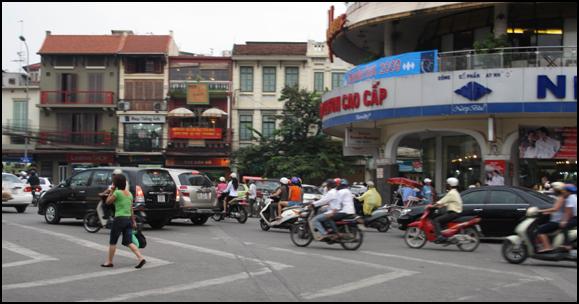 |
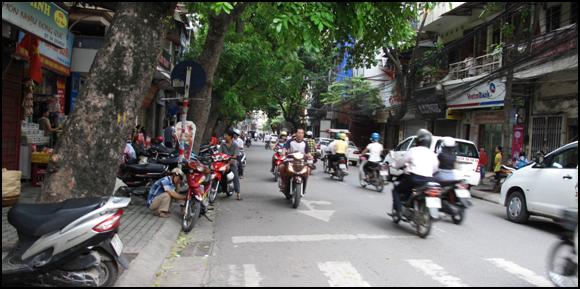
The city of motorbikes
b. Ho Chi Minh’s Mausoleum
Ho Chi Minh is venerated as a national hero and father of the Republic. Though he requested cremation, his body was embalmed and put in display in a mausoleum. Beside it there are other buildings which include a palace, Ho Chi Minh’s house and museum.

The mausoleum was closed for preservation work on the day of our visit.
.
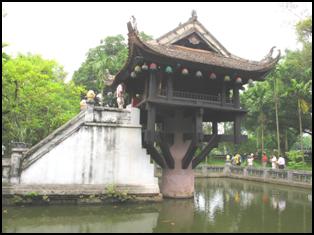 |
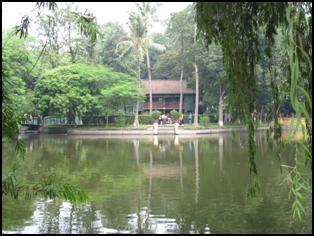 |
One Pillar Pagoda – a lotus-shaped pagoda resting on a single stone pillar rising out of a lotus pool. |
The house-on-stilts where Ho Chi Minh lived and worked from 1958 to 1969
|
 |
 |
Presidential Palace (formerly Indochina General Governor’s Palace)
|
The roots of an old tree projecting from the ground |
 |
 |
A coconut tree protruding from the trunk of an old tree! |
An old tree grown from a pot? |
c. The Temple of Literature
 |
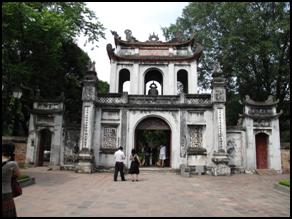 |
 |
 |
The Temple of Literature was built in 1070 as a centre of Confucian learning and to honor scholars. Soon after, it became Vietnam’s first university. The names of its graduates were engraved on stone steles and they were mounted on the back of stone turtles. The steles record 2,313 students graduated as doctor laureates.
d. Hoan Kiem Lake with Ngoc Son Temple

A red-painted wooden bridge to the Temple in Jade Island (right)


Hoan Kiem Lake –“Lake of Restored Sword” is the historical centre of Vietnam. Large soft-shell turtles have been sighted in the lake. The species is now critically endangered. Near the northern side of the lake lies Jade Island on which Ngoc Son Temple stands. It was erected in 18th Century to honor the 13th Century military leader Tran Hung Doe who fought against the Yuan Dynasty.
e. Vietnam Museum of Ethnology
The Viet made up more than 85% of the population of Vietnam. They are the largest of 54 ethnic groups belonging to 5 ethno-linguistic families.
Houses of diverse ethnic groups have been built in the open museum by artisans from the villages where these houses are traditionally built.
 |
|
The communal house of the Bahnar with a height of 19 meters. The communal house is the symbol of skill, strength of the villagers. |
The wooden sculptures encircling the tomb are intended to accompany the dead into the afterlife. |

Eda Communal House. The walls are of plaited bamboo and the roof is straw. The interior is divided into 2 areas. The first is called “Gah” which is a reception and communal area for the large extended family. The other “ok” is divided into small rooms reserved for couples.


